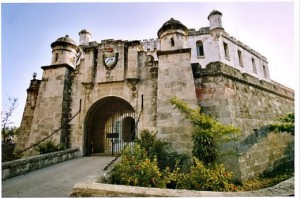Heinz Lunning was the first and only Nazi spy executed in Cuba and Latin America, to be tried for his activities on behalf of the Berlin-Rome-Tokyo during World War II he paid with his life before a firing squad at 7 and 57 minutes from the sunny morning of November 10, 1942, in the moats of the Castle of the Prince, in Havana.
Europe was shaken at the time about the devastating impact of shrapnel in the almost beginning of the war, as a result of unstoppable progress of the hundreds of armored divisions and hundreds of thousands of fanatical Nazi-fascists throughout Europe.
The intelligence services of Berlin had created in several countries in Latin America, extensive spy networks that extended throughout Chile, Argentina and Uruguay in South America and the Caribbean, particularly Cuba.
Geographical and strategic position of our Island, situated on the sea lanes closer to the United States, which served as supply routes for food and war materials to the Allied armies in Europe and Africa, did not escape the analytical acumen of services intelligence of the Third Reich.
And here arises, in the heart of the colonial area of Havana, the August figure of Heinz Lunning.
His arrival in Cuba, as revealed during the process followed in the as revealed in the trial that followed in the Emergency Court of the Province of Havana, with special legislation and jurisdiction to try all kinds of activities subversive, took place in September 1941 in the Spanish transatlantic “Villa de Madrid”, using a Honduran passport issued by the American Consul of that nation in the German city of Bremen.
To cover up his spying and providing information on the movement of ships in the bay of Havana, he rented a modest apartment, high, Teniente Rey Street No 366, which enabled him, without attracting attention, clearly envision Havana harbor entrance. And that was dedicated to the breeding of canaries, which concealed their true activity. To justify their income, the company acquired in fashion boutique “Imprint”, located on the street Industry. As he spoke the Spanish language and his complexion was swarthy, few identified as a German.
I do not know really became known as the Department of Enemy Activities of the Cuban police got the information about their existence, but is supposed to be through the American and British secret services, following the track of other Nazi spies in South America. Cuban authorities then maintained close contact and deep ties to the Federal Bureau of Investigation (FBI) in Washington.
The truth is that Lunning, supposedly members of the Gestapo, was arrested on August 6, 1942 at his home in Teniente Rey Street, where police said he held transmitters and receivers for shortwave radio, revealing documents of its activities and numerous cages with canaries.
From the investigations it appeared that Lunning reported by radio to the German submarines that roamed near our coasts, that two Cuban merchant ships, the “Santiago de Cuba” and “Manzanillo”, leading the United States, supplies for the Allied armies in Europe. The result of this information, the two merchants were sunk by torpedoes fired a few miles from our shores, with a tragic balance of hundreds of Cuban marine swallowed by the sea.
The trial lasted two months Lunning three days from the time the clerk was notified of the death sentence by firing squad., In his cell at the Castillo del Principe, November 9, 1942. According to witnesses, the spy received the news with his face pale, his hands trembled slightly when he signed the notice, but without a single gesture that showed fear, or cry at all.
A religious of the Dominican Order were allowed to provide spiritual aid and comfort a Christian. One of them spent several minutes talking with the prisoner quietly in a corner of the narrow cell and then presented a crucifix devoutly kissed Lunning.
– It’s a good Christian said the priest at retirement.
Shortly after seven o’clock began the preparations for his last walk through the tunnels vaulted stone of the ancient colonial fortress, perched on a hill, facing what is today the Revolution Square Jose Marti. They had failed requests for clemency raised by the defender. The last hope was gone.
At 7.45 am, it was found that the defendant crossed the threshold of the gate leading to the pits, followed by two monks who spoke to him about the hearing, defense, judicial and military squad responsible for the execution. He preceded an army officer, he held in his right hand a saber whose blade shone bright, the light of the sun.
Lunning, six feet tall, stocky, with more than 200 pounds, almost black hair, pale complexion and neatly trimmed mustache, walked slowly but steady steps. His hands cuffed behind his back. His serious face and arrogant stance. He was wearing blue shirt, beach short sleeves, dark pants and black shoes.
The death certificate was brief, stating the causes of death in an unusual language, like the fact it originated. It read simply:
“Internal bleeding moments of life and the indirect cause, execution of civilians by belligerent armies.”
According to data that we have achieved, Lunning was buried on November 10, 1942 in the South West FE 22 CC field in the stretch call of the charity or the poor, in the Colon Cemetery in Havana.
His remains were recovered on June 19, 1952. Subsequently authorized the transfer of his ashes to the German city of Bremen, at the request of his family, possibly his widow.
Sources: RaulQuintana/InternetPhotos/TheCubanHistory.com
Nazi spy executed in Cuba/The Cuban History/ Arnoldo Varona, Editor
ESPIA NAZI FUSILADO EN CUBA (1942)
Heinz Lunning constituyó el primero y único espía nazi fusilado en Cuba y América Latina, al ser juzgado por sus actividades a favor del eje Berlín-Roma-Tokio, durante la II Guerra Mundial- Pagó con su vida ante un pelotón de fusilamiento a las 7 y 57 minutos de la soleada mañana del 10 de noviembre de 1942, en los fosos del Castillo de El Príncipe, en La Habana.
Europa era sacudida en esos momentos por los efectos devastadores de la metralla en los casi inicio del conflicto bélico, como consecuencia de los avances incontenibles de las centenares de divisiones blindadas y de cientos de miles de fanáticos nazi-fascistas, por toda Europa.
Los servicios de inteligencia de Berlín habían creado en diversos países de América Latina, amplias redes de espionaje que se extendían por Chile, Argentina y Uruguay, en Sudamérica, y en el Caribe, particularmente en Cuba.
La posición geográfica-estratégica de nuestra Isla, situada en las vías marítimas más próximas a los Estados Unidos, que servían de rutas de aprovisionamiento de alimentos y materiales bélicos para los ejércitos aliados en Europa y África, no escapó a la perspicacia analítica de los servicios de inteligencia del III Reich.
Y es aquí donde surge, en pleno corazón de la zona colonial de la capital cubana, la figura de Heinz August Lunning.
Su arribo a Cuba- según se reveló durante el proceso que se le siguió en el según se reveló en el juicio que se le siguió en el Tribunal de Urgencia de la Provincia de La Habana, con fuero y legislación especial para juzgar todo tipo de actividades subversivas- se produjo en septiembre de 1941 en el trasatlántico español “Villa de Madrid”, utilizando un pasaporte hondureño extendido por el Cónsul de esa nación centroamericana en la ciudad alemana de Bremen.
Para encubrir sus labores de espionaje y el suministro de información sobre el movimiento de barcos de la bahía de La Habana, alquiló un modesto apartamento, alto, en la calle Teniente Rey No 366, que le permitía, sin llamar la atención, avizorar claramente la entrada del puerto habanero. Y ahí se dedicó a la cría de canarios, con lo cual encubría su verdadera actividad. Para justificar sus ingresos económicos, adquirió en sociedad la tienda de modas “Estampa”, situada en la calle Industria. Como hablaba el idioma español y su tez era trigueña, pocos lo identificaban como ciudadano alemán.
No sé llegó a conocer realmente como el Departamento de Actividades Enemigas de la policía cubana obtuvo la información acerca de su existencia, aunque se supone que fue a través de los servicios secretos norteamericanos y británicos, que seguían la pista de otros espías nazis en Sudamérica. Las autoridades cubanas mantenían entonces un estrecho contacto y profundos vínculos con el Buró Federal de Investigaciones (FBI) en Washington.
Lo cierto es que Lunning, supuesto miembros de la GESTAPO, resultó apresado el 6 de agosto de 1942 en su vivienda de la calle Teniente Rey, donde la policía dijo haber ocupado equipos transmisores y receptores de radio de onda corta, documentos reveladores de sus actividades y numerosas jaulas con canarios.
De las investigaciones se dedujo que Lunning informó por radio a los submarinos alemanes que rondaban cercanos a nuestras costas, que dos barcos mercantes cubanos, el “Santiago de Cuba” y “El Manzanillo”, conducían a Estados Unidos, avituallamiento para los ejércitos aliados en Europa. Resultado de esa información, los dos mercantes resultaron hundidos por disparos de torpedos a escasas millas de nuestras costas, con un balance trágico de cientos de marinos cubanos tragados por el mar.
El proceso contra Lunning duró dos meses y tres días, desde el momento en que el secretario del tribunal le notificó la sentencia de muerte por fusilamiento., en su celda del Castillo del Príncipe, el 9 de noviembre de 1942. Según los testigos, el espía recibió la noticia con el rostro pálido, las manos le temblaban ligeramente al firmar la notificación, pero sin un solo gesto que demostrara miedo, ni exclamación alguna.
A los religiosos de la Orden Dominico se les autorizó para suministrarle los auxilios espirituales y el consuelo cristiano. Uno de ellos permaneció varios minutos conversando quedamente con el reo en un rincón de la estrecha celda y luego le presentó un crucifijo que Lunning besó devotamente.
– Es un buen cristiano- exclamó el sacerdote al retirarse.
Poco después de las siete de la mañana se iniciaron los preparativos de su postrer caminata por los túneles abovedados, de piedra, de la vetusta fortaleza colonial, enclavada en una loma, frente a lo que es hoy la Plaza de la Revolución José Martí. Habían fracasado las peticiones de indulto elevados por el defensor. La última esperanza se había esfumado.
A las 7,45 de la mañana, se vio que el reo trasponía el umbral del portón que conducía a los fosos, seguido de los dos religiosos que le hablaban casi al oído, el defensor, los funcionarios judiciales y el pelotón militar encargado de la ejecución. Le precedía un oficial del ejército, que sostenía en su mano derecha un sable desenvainado y cuya hoja brillante refulgía, a la luz de los rayos solares.
Lunning, de seis pies de estatura, fornido, con más de 200 libras de peso, pelo casi negro, tez pálida y bigote espeso bien recortado, caminaba lentamente, pero con pasos firmes. Sus manos esposadas a la espalda. Su rostro serio y postura arrogante. Vestía camisa azul, de playa, de mangas cortas; pantalón oscuro y zapatos negros.
El certificado de defunción fue breve, señalando las causas de muerte en un lenguaje poco usual, como el hecho que lo originó. Decía sencillamente:
“Hemorragia interna de momentos de duración y la causa indirecta, ejecución de civiles por ejército beligerante”.
Según datos que hemos logrado obtener, Lunning fue sepultado el 10 de noviembre de 1942 en el campo FE Suroeste 22 CC, en el tramo llamado de la limosna o de los pobres, en el Cementerio de Colón de La Habana.
Sus restos fueron exhumados el 19 de junio de 1952. Posteriormente se autorizó el traslado de sus cenizas a la ciudad alemana de Bremen, a solicitud de sus familiares, posiblemente de su viuda.
Sources: RaulQuintana/InternetPhotos/TheCubanHistory.com
Nazi spy executed in Cuba/The Cuban History/ Arnoldo Varona, Editor





